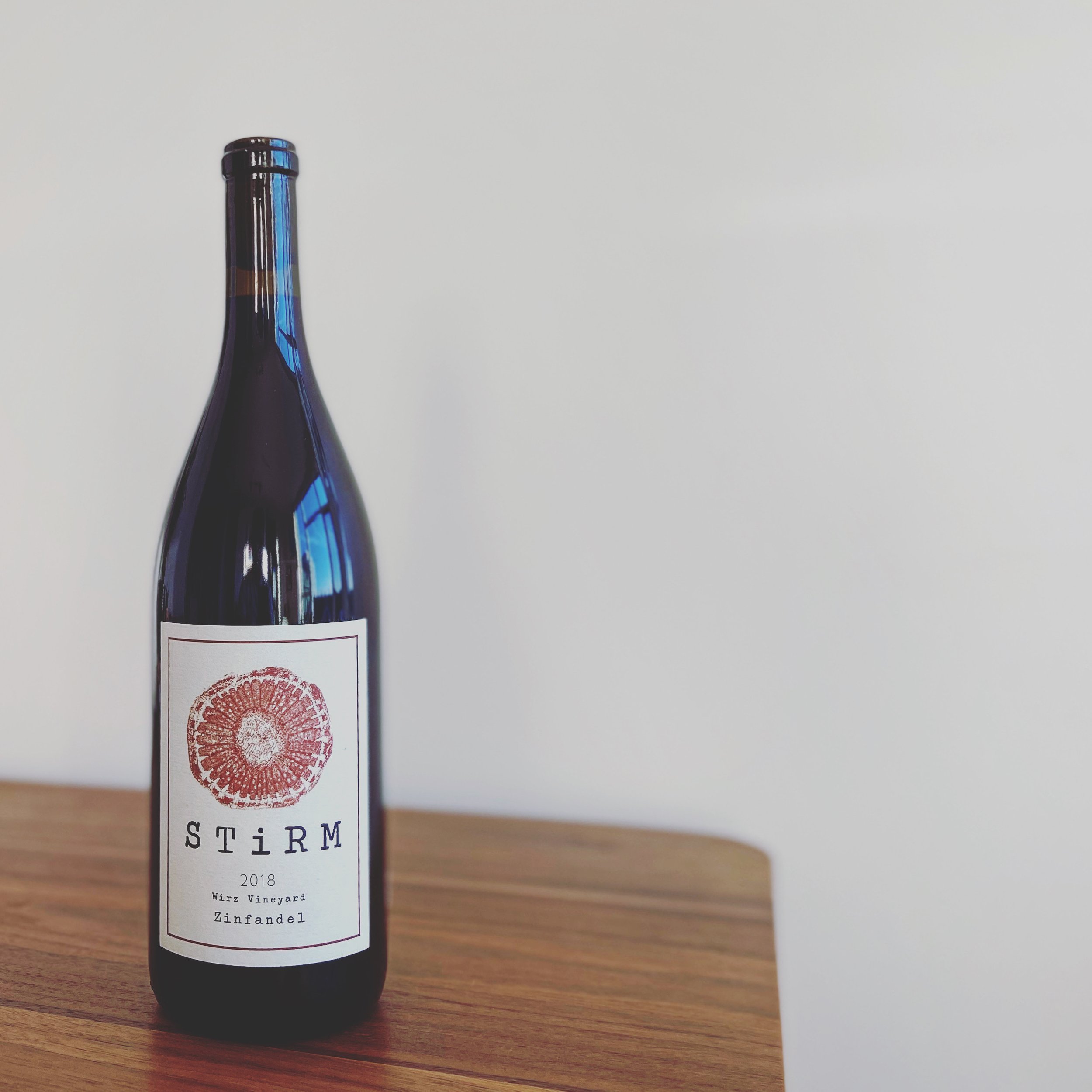STIRM WINE CO
PAST WINES
2018 WIRZ ZINFANDEL
These vines were planted in 1902. They are own rooted, organically farmed, and thrive without irrigation. Sitting at 1000 feet above sea level, Wirz Vineyard is in the obscure Cienega Valley on the San Andreas Fault Line. This vintage was infinitely milder than the scorching 2017 season. Whole clusters were fermented in old open top redwood tank with 1% Riesling. After eleven days on skins the wine is pressed off into ten-year-old barriques for an eighteen- month élevage on fine lees. One month before bottling the wine is racked into stainless steel with 9% Riesling from the same vineyard. 210 cases produced. 14.2% ABV, 3.4 pH, 7.6 g/l TA.
2018 ROSÉ
This wine is made from a blend of Riesling (97%) and Zinfandel (3%), from Wirz Vineyard. This site was planted in 1965 in the Gabilan Mountains. The soils are extremely interesting as this vineyard sits on the San Andreas Fault Line; they are primarily limestone- based clay and granite- based loam, but you can find plenty of large stones as well. The own- rooted vines yield a little over one ton per acre. The grapes were crushed for a two-day maceration before being pressed off into stainless steel. After a cold settling period the wine spontaneously ferments in tank, only receiving sulphur after malolactic conversion. The wine is bottled unfined, unfiltered. (103 Cases Produced) 12.2% ABV, 3.15pH, 6.17 TA.
2018 SONOMA VALLEY SYRAH
This wine comes from the Miers-Kuenster Vineyard in Sonoma grown by friends of Ryan’s. Whole clusters were added directly to an open-top redwood fermenter where they were crushed by foot. The wine was pressed off after ten days and finished fermenting in neutral barrel. After a nine-month élevage the wine was racked and bottled with only 10ppm of sulphur. 170 cases produced. 12.3% ABV, 3.82 pH, 5.9 g/l TA.
2018 KICK-ON RIESLING
Kick-On vineyard is located 16km east of the ocean in Los Alamos Valley, just north of Santa-Barbara. As this is an offshoot of the transverse range, the valley runs west-east which means oceanic breezes cool the vineyard daily. Ryan’s vineyard block is planted mostly on windblown sand with just a pinch of clay and chirt cobbles. Strong winds cause the vines to close their stomas which results in incredibly delayed ripening. The grapes were macerated as whole clusters for two days before being pressed off into stainless steel. After three days of cold settling the juice was racked into tank for wild fermentation. No Sulphur was added until after malolactic conversion. The wine was bottled without fining, nor filtration.
2018 LOS CHUCHAQUIS ALBARIÑO METHODE ANCESTRALE
This vineyard is planted on a warm site in Santa Ynez. Despite the heat, the Albariño vines fared really well. They were harvested early to preserve acidity and avoid overly ripe flavours. Whole-clusters were pressed into stainless steel for a hot and fast fermentation. A small amount of juice was frozen and reserved as liqueur de tirage. The wine was bottled in the spring with a small amount of the frozen juice for secondary fermentation in bottle. The resulting wine has about three atmospheres of pressure. No Sulphur was added, and it was not disgorged.
2017 SANTA CRUZ MOUNTAINS PINOT NOIR
In 2016 Ryan took over farming a tiny vineyard near the mountain town of Glenwood, east of Santa Cruz. Planted in 1997, this organic two-acre plot is on a 30% grade. It is neither tilled nor irrigated. Soils here are mostly sandy loam, decomposed from lompico sandstone. This truly is a vineyard in the forest – it’s surrounded by redwoods, oak, and bay trees. After a growing season defined by cool night, the grapes were harvested in early September. Whole clusters were fermented in 1960s open-top redwood fermenter for two weeks before being pressed off into neutral oak puncheon. After 18 months, the wine was racked and bottled.
2018 LOS CHUCHAQUIS ROSA DEL PERU
Ryan Stirm was able to make a whopping 350 bottles of Rosa del Perú (Mission, País) this year. Planted in the Cienega Valley, this vineyard boasts vines well over a century old, and black limestone soils which help the grapes retain acid in the heat. The wine was bottled without added Sulphur.
2016-17 KICK-ON RIESLING
Kick-On vineyard is located 16km east of the ocean in Los Alamos Valley, just north of Santa-Barbara. As this is an offshoot of the transverse range, the valley runs west-east which means oceanic breezes cool the vineyard daily. Ryan’s vineyard block is planted mostly on windblown sand with just a pinch of clay and chirt cobbles. 2016 say a wet winter which helped replenish the water-table, but yields were still incredibly low. Cold nights helped retain acidity and they eventually harvested on September 14th at 21.1 Brix. The grapes were macerated as whole clusters for a full day before being pressed off into stainless steel. After three days of cold settling the juice was racked into stainless steel for wild fermentation. No Sulphur was added until after malolactic conversion. The wine was bottled on June 27th without fining, not filtration. 12.9% ABV (227 Cases Produced)
2017 WIRZ ZINFANDEL
These vines were planted in 1902. They are own rooted, organically farmed, and thrive without irrigation. Sitting at 1000 feet above sea level, Wirz Vineyard is in the obscure Cienega Valley on the San Andreas Fault Line. A late September heat spike (47ºC) caused the grapes to jump from 10 to 30 Brix in two days. After destemming, the wine was fermented in old open top redwood tank. It wild fermented up to 16.8% ABV despite having incredibly low YAN levels. After aging for 18 months in neutral oak, 18% Riesling was blended in to lower the acidity and alcohol level to 15.8%. It is bottled unfined and unfiltered.
2015-17 WIRZ RIESLING
Own-rooted, head trained, dry farmed Riesling vines planted in the 60s are what make this wine so special. Sitting at 1000 feet above sea level, Wirz Vineyard is in the obscure Cienega Valley on the San Andreas Fault Line. The grapes were harvested with about 2% botrytis. Whole clusters were crushed and the juice macerated with the skins for a short period. Spontaneous fermentation was carried out in stainless steel and the wine spent the next several months on the fine lees. It was bottled unfined and unfiltered. 13.5% ABV (TA 7g, pH 3.25, RS 0.7g/l) (98 Cases Produced)
2015-17 KICK-ON EOLIAN RIESLING
The grapes were crushed and were permitted to sit on the skins for 6 hours. Botrytised grapes were vinified separately. Sulphur was only added after secondary fermentation and right before bottling. The wine fermented in stainless steel but élevage was carried out in neutral puncheons. The botrytised wine was blended back in several weeks before bottling. 12.3% ABV (TA 7.7, pH 3.11, RS 0.5g/l) (42 Cases Produced)
2018 COMPANION WINE CO. MALVASIA CAN
This year, Ryan teamed up with Scott Schultz from Jolie-Laide. This organically farmed vineyard is located at the southern end of the Vaca Mountains. Soils here are predominantly volcanic. The grapes were crushed and permitted to sit on the skins for just shy of a day before being pressed off into stainless steel for fermentation. It was canned with minimal filtration, no fining, and very little Sulphur.
2018 COMPANION WINE CO SAVVY B CAN
Gina Hildebrand is one of the loveliest humans on planet earth. Her winery (Lady of the Sunshine) focuses on fruit she farms biodynamically up in the Sierra Foothills. The cuvée she made for Companion Wine Co is 2/3 organic Sauvignon Blanc from Talley Vineyard in the Edna Valley, and 1/3 Biodynamic Chardonnay from her own vineyard. This wine will probably never exist again because the economics are laughable.
2018 COMPANION WINE CO ROSÉ CAN
As you’d expect, this wine is made from 98% Old Vine Riesling with 2% Zinfandel blended in. Ryan & Andrew tried to call this wine Vitamin ‘R’ but the Trade & Tax Bureau weren’t impressed. The wine is direct pressed into stainless steel, wild fermented after a short settling period, and canned with minimal sulphur after a quick élevage. They wanted to use this wine’s label to draw attention to California’s dwindling Coho Salmon population. A portion of their proceeds will be donated to Caltrout to help save them.
2018 companion wine co Gruner can
Thanks to a fecund season at Kick-On Ranch in Santa Barbara, our hero Graham Tatomer was able to make a Grüner Veltliner for Companion Wine Co. He learned his craft at Emmrich Knoll in the Wachau, Austria. As such, this isn’t really a natural wine. They blocked malolactic conversion with sulphur and filtered the wine before canning. The fruit was extremely expensive for this cuvée so they’re claiming it might not happen again, which would be a shame because the quality is outstanding.
2016-17 RIESLING CANS
Despite the unassuming packaging, this is a serious wine. The grapes come from the organically farmed Zabala vineyard in Arroyo Seco (Monterey). They were harvested in two passes for optimal ripeness. The strong cool winds here kept the grapes relatively free from botrytis. The grapes were whole-cluster crushed and the juice sat with the skins for a full day. Spotaneous fermentation occurred at low temperatures in stainless steel. The wine was then lightly sulphured and the temperature was dropped to prevent malolactic conversion. The wine is lightly filtered but not fined and canned with CO2 left over from fermentation. 11% ABV (TA 7.5g, pH 3.11, RS 5.1g/l) (225 Flats Produced)
2016 SANTA CRUZ MOUNTAINS PINOT NOIR
In 2016 Ryan took over farming a tiny vineyard near the mountain town of Glenwood, east of Santa Cruz. Planted in 1997, this organic two-acre plot is on a 30% grade. It is neither tilled nor irrigated. Soils here are mostly sandy loam, decomposed from lompico sandstone. This truly is a vineyard in the forest – it’s surrounded by redwoods, oak, and bay trees. After a growing season defined by cool night, the grapes were harvested on September 12th. Whole clusters were fermented in open-top fermenter for nine days before being pressed off into neutral oak puncheon. After 18 months, the wine was racked and bottled (60 Cases Produced)
2016 OLD VINE GRÜNER VELTLINER
In 1972 Rancho Arroyo Perdido became one of the earliest vineyards planted in Santa Ynes. The original block of Cabernet Sauvignon and Sauvignon Blanc were dry farmed thanks to the valleys accumulation of deep, dark clay-loam. In 2008 a small portion of the vines were grafter over to Grüner Veltliner – the 50+ year old rootstocks are still doing their job beautifully. The grapes were harvested on September 28th and were whole-cluster crushed. The juice macerated with the skins for a day before being pressed off into stainless-steel for cold settling. The wine is then racked into fresh stainless steel for spontaneous fermentation; no Sulphur is added until after malolactic conversion. The wine is bottled on June 27th after a third racking. 11.2% ABV (145 Cases Produced)














